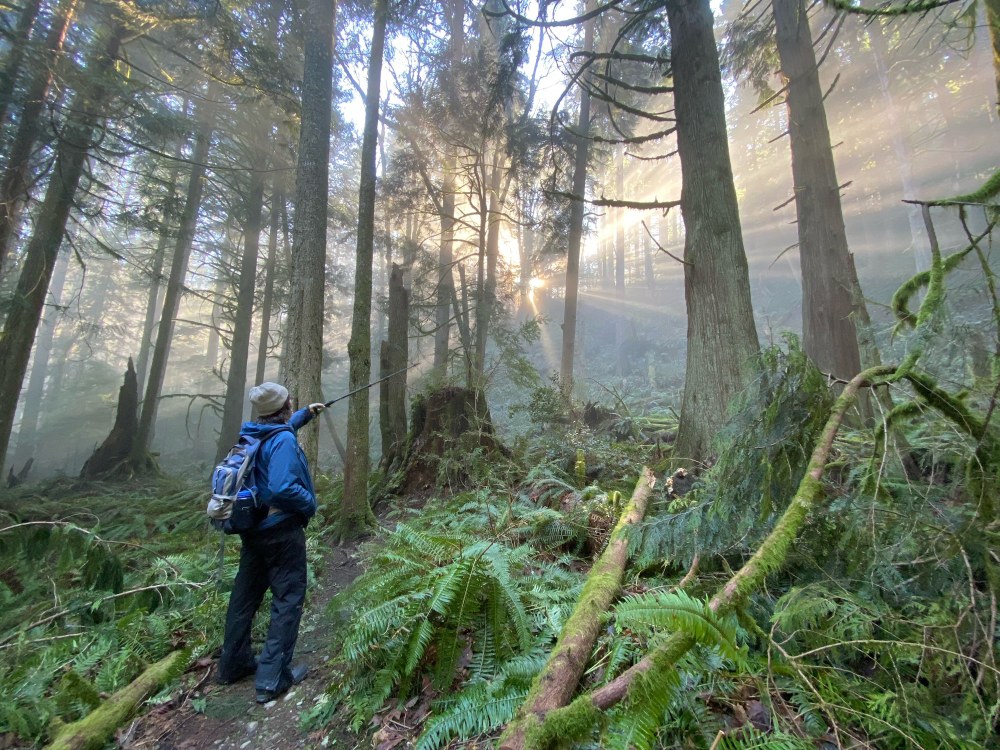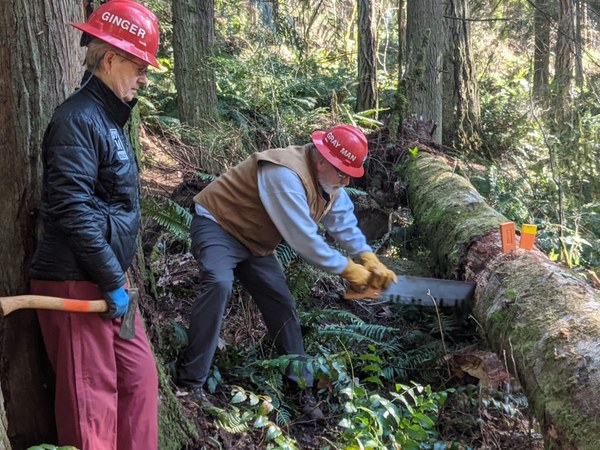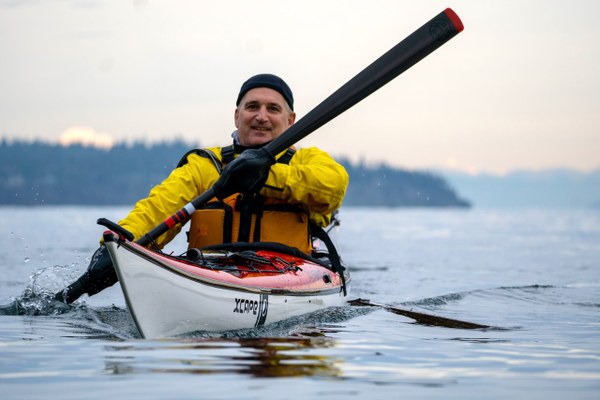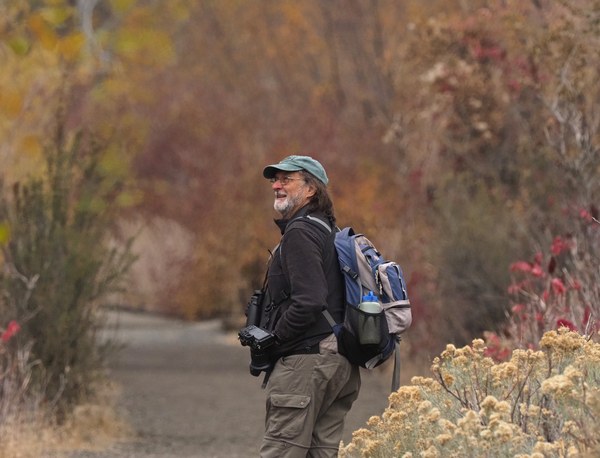
Although snow-capped mountains and freshly-groomed trails dominate the public imagination this time of year, not all winter activities are snow-centered. This is especially true in the Pacific Northwest, where we have an abundance of activities to enjoy year-round with just a few modifications. In celebration of The Mountaineers diverse offerings throughout all four seasons, we connected with a few of our volunteers to learn how they continue to stay active throughout the chilliest months.
Peter Hendrickson & Nancy Temkin
Urban Walking, 17-year members
For many walkers and hikers, the wet, gray days of Northwest winters invites (really, compels) us to get outside and feel good about the money spent on parkas, rain pants, trail shoes, and rain hats. Yes, you can be comfortable in the light rain - look at the kids outside at recess on a damp day! Urban Walks are the newest version of Mountaineers hikes, always two miles or longer in urban and suburban settings where there’s reliable cell service and good access to emergency services. Both Foothills and Seattle have Urban Walking sub-committees.
We’re lucky in the greater Seattle area as options abound in winter. Seattle Stairway Walks and Seattle Walks are favorite books, both great for clever routes and information on local history, architecture, and the natural world. Craig Romano’s Urban Walks series extends the reach to many more urban areas beyond Seattle.
A favorite with our grandchildren (11 to date!) is an urban walk two or so hours up and around Queen Anne, followed by two hours (plus lunch) at the MOHAI, Seattle Center, National Nordic Museum, or Seattle Art Museum. The shift from “out and damp” to “in and dry” reliably delights, especially in winter. And it works just as well with Tacoma grandkids on those hilly streets and in museums. Sometimes we stay in city limits and stitch together a string of parks or expand a Seattle Times suggested route. The coffee, pastries, and popsicles found along the way fuel our long treks.
Jim French
Stewardship, 24-year member
Winter is an excellent time to improve the health and enjoyment of local parks, forests, trails, preserves, and refuges. Most land managers need help, and this is the time to get the larger or more troublesome projects done. There are fewer visitors and the associated distractions in winter, which gives them more time and attention for projects. The land seldom freezes or catches on fire, and there’s plenty of rain to help habitat plantings get a healthy start.
 Jim French and Ginger Sarver at a stewardship party in Tolmie State Park. Photo courtesy of Jim French.
Jim French and Ginger Sarver at a stewardship party in Tolmie State Park. Photo courtesy of Jim French.
The trails we have adopted in the Olympic National Forest are snow-bound fall through spring, so we move down to lowland projects for the winter. Staying close to home means we have to do less driving, and some projects are half days, so we can take a short hike or socialize at a local venue afterward. Within the Olympia Branch our stewardship crew is known as enthusiastic and hard-working. As such, other branch members periodically report trail problems they observe on local hikes or share news about local stewardship projects with us.
Last winter we received reports that trees were down on local trails at Tolmie State Park and in DNR’s Woodard Bay Natural Resources Conservation Area. We have a history of volunteering at both locations, so after contacting the area managers we arranged work parties. In the following months we made eight trips to Tolmie and six trips to Woodard Bay clearing the trail of downed trees, repairing boardwalks (puncheon), improving drainage, and learning new skills and trail techniques. We enjoy being involved in local work projects because we can take family and friends to enjoy the fruits of our labors. When we are out volunteering on local trails we often see people we know, which gives us an opportunity to invite them to join in.
Joel Guay
Sea Kayaking, 6-year member
Kayaking originated as a winter activity some 4,000 or so years ago, so it’s ironic to me that its now often seen as a summer activity. It began as a means of transportation and hunting for the indigenous peoples of the frozen far north, like the Inuit and Aleut. So you could call it one of the original winter sports. While the peoples of the Salish Sea don’t appear to have used the kayak, they did use the close cousin of the kayak - the canoe - and used it extensively for travel, hunting, and fishing. These waters have been a four-season source of food and marine highway for thousands of years.
 Joel Guay on the north side of Bainbridge Island. Photo by Will Wade.
Joel Guay on the north side of Bainbridge Island. Photo by Will Wade.
I like the winter sea kayaking day trips because they make good use of the short daytime hours. The transit to the launch and return home is generally in the dark, reserving the light for paddling. And a dry suit is more comfortable on a cool day than a hot one, even if the water is still only around 50 degrees.
Arriving at a new location by sea is so different than walking or driving, if only because you need to cross the tide line to get there. That water-to-shore transition is itself sometimes an adventure as well, and always refocuses the mind on the environment.
Tom Bancroft
Naturalist, 6-year member
Winter is spectacular for naturalists as it offers the opportunity to focus on mosses, lichens, birds, and geology. Our moss and lichen class happens in February, and it generally fills within hours of opening. Different species flourish in various conditions, so you’ll find us inches from trunks, logs, the ground, and even stream rocks. A student remarked, “Wow, just slow down and look - this forest is alive.”
 Tom Bancroft at Cowiche Canyon. Photo courtesy of Tom Bancroft.
Tom Bancroft at Cowiche Canyon. Photo courtesy of Tom Bancroft.
Someone once said, "Ah, naturalist hikes, they’re just a summer thing!” I cringed, not knowing if they were serious. Dozens of bird species, ducks, geese, raptors, songbirds, and many more come to Washington just for the winter; we are their “beach.” A trip to Nisqually National Wildlife Refuge might find a Peregrine Falcon chasing Cackling Geese or Dunlins, all species visiting from the north. Birding at Fir Island might see a Short-eared Owl quartering the marsh. A morning stroll at Edmond’s waterfront could net Brants, Grebes, Loons, or even a Murrelet. Once on a weekend trip to the Okanogan, we located Gray-crowned Rosy-Finches, a species that nests high in the mountains.
Give me a pair of snowshoes, and I’ll show you nature at its best. Hug a 700-year-old mountain hemlock to revitalize the soul. Follow the tracks of a Snowshoe Hare to see where it had breakfast. Watch Snow Buntings work the rubble for seeds. It might be winter, but life goes on.
This article originally appeared in our winter 2023 issue of Mountaineer magazine. To view the original article in magazine form and read more stories from our publication, visit our magazine archive.
 Michelle Song
Michelle Song